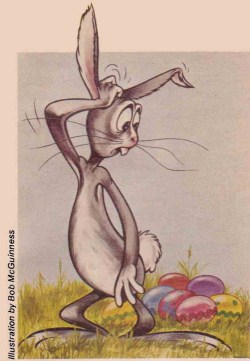 |
Eggs, rabbits and hot cross buns are Easter symbols familiar to us all. Yet many of us might be shocked or surprised at the real origin and meaning of many of our allegedly "Christian" Easter customs.
Nearly all of the symbols and customs involved in the modern "Christian" observance of Easter are actually not Christian at all, but derive from ancient pagan European mythology and superstition. The ancient pagan symbols have simply been taken over into mainstream Christianity and given a pseudo-Christian veneer.
The modern word "Easter" itself is evidently derived from the name Eostre or Eostur, an ancient Teutonic goddess of the spring months, with whom were doubtless associated spring fertility rites (Bede, De Temp. Ratione, 15). The biblical term associated with the observance of Jesus' death is called the Pascha, a Greek term used to translate the Hebrew word "Passover." Unfortunately, we know little more about the goddess Eostre than her name.
Actually, the name "Easter" has a remarkable similarity to the name of that ancient Assyrian and Babylonian goddess Ishtar! The
|
Phoenicians called her Astarte and the Teutons addressed their goddess as Eostre. Could all of these "mother-of-god" figures be one and the same?
The egg of course, has long been a symbol of reproduction and fertility representing the earth, life, or the seat of the soul. In ancient Egypt the egg had magical and religious significance for the afterlife: in ancient Rome eggs were used to cast magical spells (Funk and Wagnalls Standard Dictionary of Folklore, Mythology and Legend, p. 341).
The modern use of eggs at Easter time probably originated in early medieval fertility rites. In France during the 17th century a bride had to break an egg upon entering her new house in order to ensure she had children. In Germany, a mixture of eggs, bread and flour was smeared on a plow on the Thursday before Easter so that the coming harvest would be plentiful (ibid). In some areas of Europe, if eggs were not exchanged at Whitsuntide the hens would supposedly stop laying. Thus our modern Easter egg is little more than an ancient European fertility symbol.
The European rabbit or "Easter bunny" was also long revered as a fertility symbol of the love goddess Venus (or her Germanic equivalent). In early pagan Europe, rabbits were actually sacrificed to the goddess Venus (Handworterbuch des Deutschen Aberglaubens, vol. 4, col. 961). Throughout much of Europe, the rabbit has traditionally been viewed as a creature of magical power and influence (ibid). When modern parents assure their children that the Easter bunny laid those brightly colored eggs, they are actually following practices known long ago in pagan Europe.
Hot cross buns are another symbol associated with Easter, and along with other Easter pastries they make it a high-calorie holiday. Hot cross buns also go back to pagan offerings on ancient holy days, the cross probably replacing pagan symbols or images. "As in so many other instances where pagan ritual was Christianized, nothing is more likely than that the Cakes used at pagan festivals became, by an easy transition, cakes associated with Christian festivals. Among cakes which may have had this history may be mentioned Yule cakes . . . hot cross buns on Good Friday, Easter cakes . . . ." (Hastings Encyclopedia of Religion and Ethics, vol. II, pp. 60-61). Like so many other "Christian" symbols, hot cross buns have a long pagan history.
Many modern Christians doubtless feel that these pagan customs have little or nothing to do with their actual Christian faith in Jesus Christ as their resurrected Savior. Yet do not these customs and symbols obscure, especially for children, the real meaning of the death of Christ and the true symbolism associated with it — bread and wine (Matt. 26:26-28)? If you paint your eggs this year and roll them across the lawn, you might want to think about it.